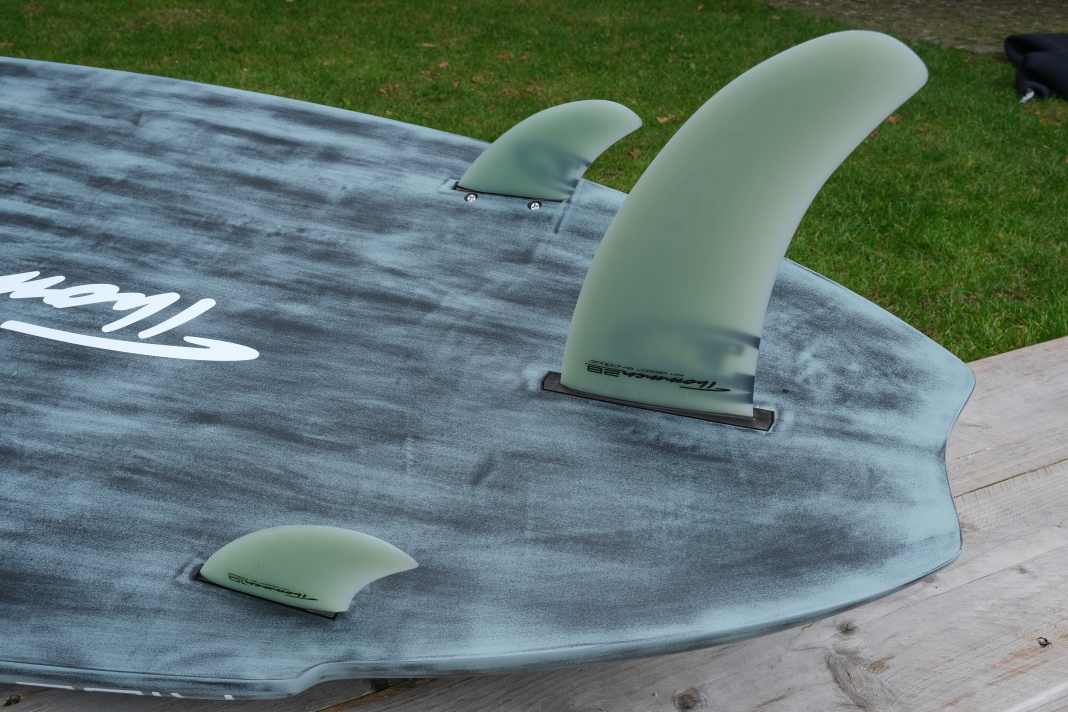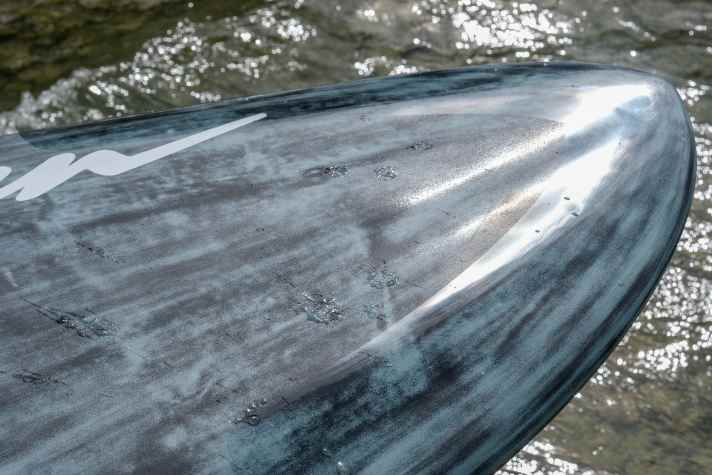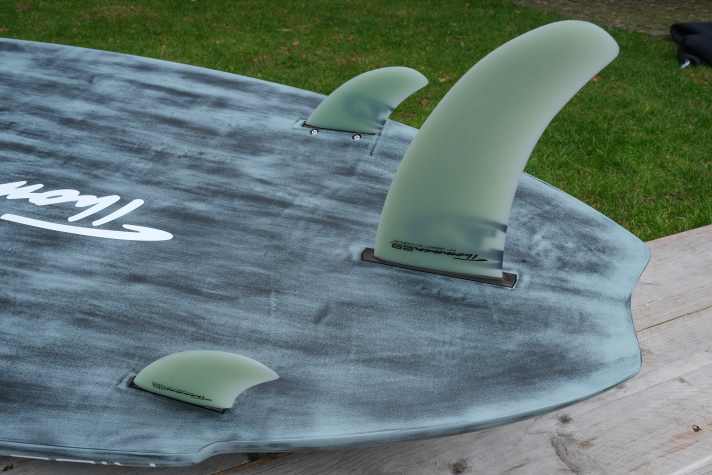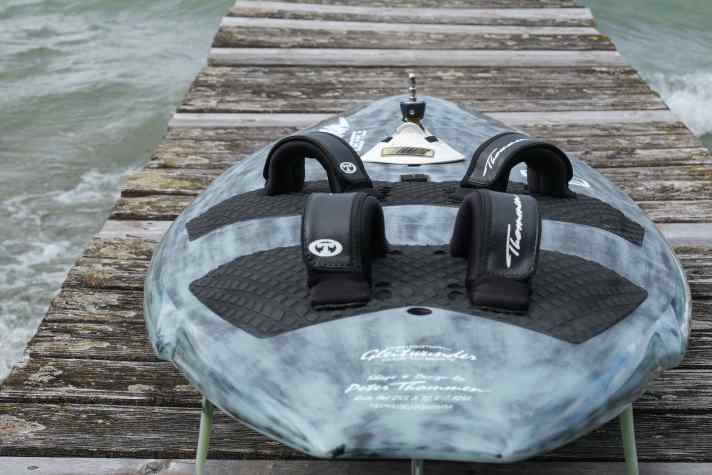Already ridden: Freerideboard Thommen Ride 125 LTD with three fins on test
Stephan Gölnitz
· 17.09.2025






"But it looks good" - that's the only comment you'll hear about the exclusive LTD construction in custom look. The board with the three fins undoubtedly has a high grab factor. You just want to stroke the glossy lacquered nose (but that's actually so that the sail doesn't get unnecessarily sanded when catching up) - or grab the particularly slim rails.

Thommen Ride 125 LTD: Shape and specials
Peter Thommen also relies on the freeride board Ride, as well as the large Thommen Gleitwunder 165 from our early gliding testThe new board is based on a flat, long and rather narrow shape concept with three fins. Let's take a look at this in detail: The shape of the Tommen Ride 120 LTD is kept extremely flat in both the underwater hull and the deck design, with very little upturn towards the bow. The still very wide nose has a well thought-out detail: Non skid paint has been widely avoided here. Instead, there is a glossy finished laminate, which protects the sail when catching up. The non-skid paint itself is pleasantly grippy without being excessively rough. There is a practical recessed grip in the centre of the board, as with SUP boards, which makes it easier to carry. This can be closed with a foam block to prevent accidentally slipping in with your toe.
The underwater shape is largely flat with a double concave, but with almost no V-shape. This double concave is moderately pronounced. In the front area of the planing surface, strong lateral bevels are noticeable - the double concave is limited to two narrow tubes in the centre area, while the planing surface is flat again towards the rail. The rails themselves are extremely thin for this board class with a very small radius. There is also a slight concave at the front of the deck in the longitudinal direction, which is intended to provide additional rigidity through this construction - a principle that is familiar from support profiles. The tail presents itself as a swallow tail with a winger, a shape that has become rare today and gives the board an attractive appearance.

Comfortable standing position
The combination of the step rail (see photo gallery) and the straps positioned far inwards on a curved deck ensures a relaxed position of the ankles in the straps. Above all, however, because the fins do not create a great capsize moment. On boards with large single fins (around 38 - 40 cm for 125 litres), such a far inboard position is often less comfortable for sporty freeriding.

Thommen Ride 125 LTD: Riding impressions and performance
Despite its 120 litres, the Thommen Ride 120 LTD is more agile and slightly wobbly when planing due to its smaller width compared to other boards in this volume class. However, thanks to its long length and flat planing curve, it accepts even light winds well for planing, slides into a semi-planing position first and thus enables easy entry into the foot straps. This is also because there is plenty of space between the straps and the rail. In the acceleration phase, however, it is noticeable that the counter support of a large, long fin with a corresponding lever is missing - the board simply needs some time to reach maximum speed. With normal pressure in the sail, however, you can then position yourself in the straps in a particularly relaxed manner and hang out in the harness.
This is where the stress-free part of riding begins: the board requires almost no body tension to stay on course. The nose always stays down, feeling very flat in light winds and completely smooth in strong winds. It glides freely over all choppy waves without you having to push with your back foot. Lateral rolling is largely unknown to the board. The constant and demanding stabilisation of the gliding position by applying pressure with the toes of the rear foot, which is necessary with some boards, is largely eliminated here. However, very performance-orientated freeriders will also search in vain for the centre of effort for the "kick down", the board cannot be surfed exclusively "over the fin" like a slalom board. The board actually glides rather stably on the planing surface in a very wide wind range. You almost have the feeling that you could fall off the board and the Glide would still continue to surf the seas - like a ghost board, ownerless and alone.
With the 7.2 square metre test sail, the board felt it had reached its sensible upper sail limit in the test. In the lower planing range you can maintain height, but not as effectively as with a single fin board. When surfing permanently in the lower planing wind range, you are therefore a little more concerned with maintaining height, which then improves with normal pressure in the sail. As the wind increases, the board reveals its true strengths - the more wind, the more comfortable it feels, with the balanced pressure on both feet remaining constant. Full-throttle rides are then possible on all courses, even with a powered-up 5 square metre sail, without the need to change fins, as the small tail fins never develop problematic leverage, even at high speeds. The board always glides flat over the water and stable around all axes without the need for a lot of footwork.
The three-fin board in a manoeuvre check
The small tail, the three fins and the thin rails come into their own in tight jibes - at full speed, the board can be snapped around the corner with extremely secure grip and particularly tight turns. Medium jibes are also possible with good speed, although the board is not the best glider and requires more active steering. The required foot pressure is pleasantly low and easy to control even for lighter riders. Only radical carving jibes require at least a little caution, as the thin front rails can easily get stuck in a chop. Contrary to popular belief that thin edges only offer advantages in the jibe, they also generate slightly less lift, which can lead to unintentional braking. In smoother water, on the other hand, controlled carves are very sporty and fast; in very choppy water, narrow or classic, medium power jibes are recommended.
Area of application and target group
The Thommen Ride 120 LTD is clearly a comfort-orientated board, whose strengths lie in its controllability, easy straight-line riding, easy launching and wide range of use. With a sail area of 7 square metres, the fins seem a little overstretched in the lowest planing wind range without causing a real spin-out - the guidance is then no longer one hundred percent. The ideal sail area is between 6.7 and 5.0 square metres, but this covers a wide range of conditions. The board unfolds its full potential not in conditions at the lower wind limit, but in normal freeride wind. It is aimed at riders who prefer relaxed surfing and do not want to be in permanent racing and sport mode. The Thommen Ride 120 LTD is not a pimped-up freeracer, but a classic freeride board for connoisseurs who value control and comfort and can do without top sporting performance. The planing position is rather flat, but the shape absorbs occasional bumps in the chop with pleasant damping.
Surf summary of the Thommen Ride 125 LTD
The Ride is a special board that is not just another representative of the freeride category. You should bear this in mind before making a purchase. The board stands for very good control, easy planing and relaxed, comfortable freeriding in a wide wind range - even when the wind is already blowing hard for comparatively small sail sizes. On the other hand, you shouldn't expect any performance miracles from the 3-fin concept in the lower planing wind range. The performance is decent, but not on a par with boards with a single, long centre fin. Nevertheless, the three fins are light-footed and low-drag on fast downwind courses. The Glide can show its strengths when properly powered up, when control is the most important factor.
Technical specifications:
Board:
- Volume: 120 litres
- Length: 2.55 m
- Width: 72 cm
- Shape: Flat with double concave, barely V-shaped
- Tail: Swallowtail with winger
- Rails: Step rails, very slim with a tight radius
Finns:
- Setup: Thruster (3 fins)
- Centre fin: 28 cm, power box
- Side fins: 10 cm, slot boxes, strongly curved backwards
- Outline: Freemove characteristic
Equipment:
- Non skid paint: Good grip, not too rough
- Recessed grip in the centre with lockable foam block
- Nose without non skid paint
- Comfortable foot straps, double-bolted
Recommended sailing area:
- Ideal range: 5.0 to 6.7 square metres
- Maximum size: approx. 7.2 square metres
Info under thommen1.com

